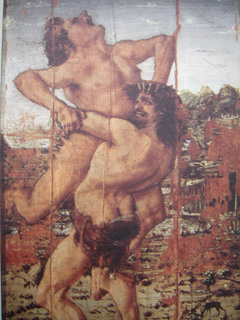Tomorrow is International Earth Day, the start of a week of protests against man’s continuing destruction of the natural environment. Today’s tangentially related but perhaps metaphorically appropriate painting shows the mythical giant Antaeus, son of Gaia, classical goddess of the Earth, having the life crushed out of him by Hercules.
The picture was painted in about 1460 and has been convincingly attributed to the Florentine artist Antonio del Pollaiuolo, possibly with some assistance from his brother Piero. One of two surviving paintings from the Pollaiuolo workshop on the theme of “The Labours of Hercules”, it is a small image, painted in egg tempera on a panel of wood not much larger than a paperback novel.
Now in the Uffizi Gallery, this painting and a depiction of Hercules Slaying the Hydra were presumed lost for some twenty years after disappearing during the German occupation of
The existence of that series is known from various documentary references. In 1494 Antonio del Pollaiuolo wrote a letter from Rome to Florence in which he pleaded to be allowed home to Tuscany to escape an outbreak of plague, hoping that the Medici would...


